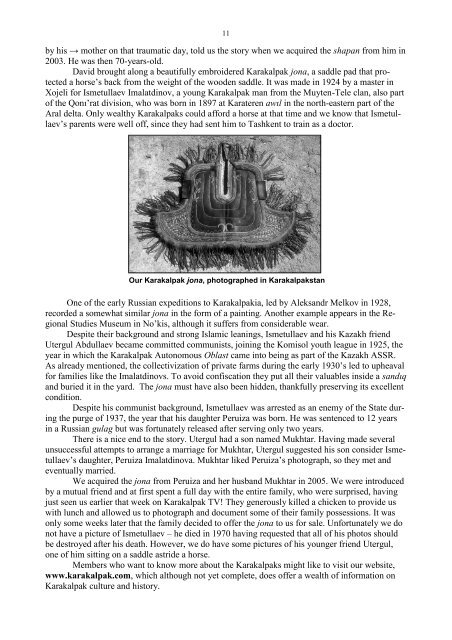Download - OATG. Oxford Asian Textile Group
Download - OATG. Oxford Asian Textile Group
Download - OATG. Oxford Asian Textile Group
Create successful ePaper yourself
Turn your PDF publications into a flip-book with our unique Google optimized e-Paper software.
11<br />
by his → mother on that traumatic day, told us the story when we acquired the shapan from him in<br />
2003. He was then 70-years-old.<br />
David brought along a beautifully embroidered Karakalpak jona, a saddle pad that protected<br />
a horse‘s back from the weight of the wooden saddle. It was made in 1924 by a master in<br />
Xojeli for Ismetullaev Imalatdinov, a young Karakalpak man from the Muyten-Tele clan, also part<br />
of the Qonı‘rat division, who was born in 1897 at Karateren awıl in the north-eastern part of the<br />
Aral delta. Only wealthy Karakalpaks could afford a horse at that time and we know that Ismetullaev‘s<br />
parents were well off, since they had sent him to Tashkent to train as a doctor.<br />
Our Karakalpak jona, photographed in Karakalpakstan<br />
One of the early Russian expeditions to Karakalpakia, led by Aleksandr Melkov in 1928,<br />
recorded a somewhat similar jona in the form of a painting. Another example appears in the Regional<br />
Studies Museum in No‘kis, although it suffers from considerable wear.<br />
Despite their background and strong Islamic leanings, Ismetullaev and his Kazakh friend<br />
Utergul Abdullaev became committed communists, joining the Komisol youth league in 1925, the<br />
year in which the Karakalpak Autonomous Oblast came into being as part of the Kazakh ASSR.<br />
As already mentioned, the collectivization of private farms during the early 1930‘s led to upheaval<br />
for families like the Imalatdinovs. To avoid confiscation they put all their valuables inside a sandıq<br />
and buried it in the yard. The jona must have also been hidden, thankfully preserving its excellent<br />
condition.<br />
Despite his communist background, Ismetullaev was arrested as an enemy of the State during<br />
the purge of 1937, the year that his daughter Peruiza was born. He was sentenced to 12 years<br />
in a Russian gulag but was fortunately released after serving only two years.<br />
There is a nice end to the story. Utergul had a son named Mukhtar. Having made several<br />
unsuccessful attempts to arrange a marriage for Mukhtar, Utergul suggested his son consider Ismetullaev‘s<br />
daughter, Peruiza Imalatdinova. Mukhtar liked Peruiza‘s photograph, so they met and<br />
eventually married.<br />
We acquired the jona from Peruiza and her husband Mukhtar in 2005. We were introduced<br />
by a mutual friend and at first spent a full day with the entire family, who were surprised, having<br />
just seen us earlier that week on Karakalpak TV! They generously killed a chicken to provide us<br />
with lunch and allowed us to photograph and document some of their family possessions. It was<br />
only some weeks later that the family decided to offer the jona to us for sale. Unfortunately we do<br />
not have a picture of Ismetullaev – he died in 1970 having requested that all of his photos should<br />
be destroyed after his death. However, we do have some pictures of his younger friend Utergul,<br />
one of him sitting on a saddle astride a horse.<br />
Members who want to know more about the Karakalpaks might like to visit our website,<br />
www.karakalpak.com, which although not yet complete, does offer a wealth of information on<br />
Karakalpak culture and history.

















